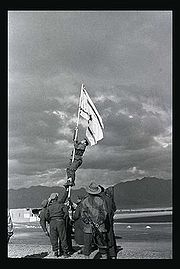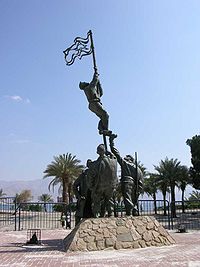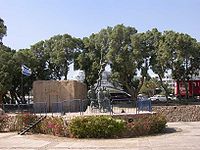
Operation Ovda
Encyclopedia

Israel Defense Forces
The Israel Defense Forces , commonly known in Israel by the Hebrew acronym Tzahal , are the military forces of the State of Israel. They consist of the ground forces, air force and navy. It is the sole military wing of the Israeli security forces, and has no civilian jurisdiction within Israel...
during the 1948 Arab-Israeli War
1948 Arab-Israeli War
The 1948 Arab–Israeli War, known to Israelis as the War of Independence or War of Liberation The war commenced after the termination of the British Mandate for Palestine and the creation of an independent Israel at midnight on 14 May 1948 when, following a period of civil war, Arab armies invaded...
, from March 5 to March 10, 1949. It was the last campaign undertaken by the IDF during the war and its objective was to capture the southern Negev
Negev
The Negev is a desert and semidesert region of southern Israel. The Arabs, including the native Bedouin population of the region, refer to the desert as al-Naqab. The origin of the word Neghebh is from the Hebrew root denoting 'dry'...
desert, which was claimed by the Kingdom of Jordan
Jordan
Jordan , officially the Hashemite Kingdom of Jordan , Al-Mamlaka al-Urduniyya al-Hashemiyya) is a kingdom on the East Bank of the River Jordan. The country borders Saudi Arabia to the east and south-east, Iraq to the north-east, Syria to the north and the West Bank and Israel to the west, sharing...
to be under Jordanian control in the armistice talks of 1949
1949 Armistice Agreements
The 1949 Armistice Agreements are a set of agreements signed during 1949 between Israel and neighboring Egypt, Lebanon, Jordan, and Syria. The agreements ended the official hostilities of the 1948 Arab-Israeli War, and established armistice lines between Israeli forces and the forces in...
.
The southern Negev was designated to be part of the Jewish State in the 1947 UN Partition Plan
1947 UN Partition Plan
The United Nations Partition Plan for Palestine was created by the United Nations Special Committee on Palestine in 1947 to replace the British Mandate for Palestine with "Independent Arab and Jewish States" and a "Special International Regime for the City of Jerusalem" administered by the United...
. The name uvda (עובדה) is Hebrew
Hebrew language
Hebrew is a Semitic language of the Afroasiatic language family. Culturally, is it considered by Jews and other religious groups as the language of the Jewish people, though other Jewish languages had originated among diaspora Jews, and the Hebrew language is also used by non-Jewish groups, such...
for "fact", referring to the operation's objective to establish de facto
De facto
De facto is a Latin expression that means "concerning fact." In law, it often means "in practice but not necessarily ordained by law" or "in practice or actuality, but not officially established." It is commonly used in contrast to de jure when referring to matters of law, governance, or...
Israeli sovereignty over the territory in question, rather than actually conquer it. As such, the Israeli forces did not meet significant resistance on their way. The region claimed during this operations is now referred to as Ovda
Ovda
Ovda or Uvda may refer to:*Ovda **Operation Uvda**Ovda Israeli Air Force Base**Ovda International Airport*Ovda Regio on Venus...
.
The Negev
Negev Brigade
The 12th Negev Brigade was an Israeli infantry brigade that served in the 1948 Arab-Israeli war. It was commanded by Nahum "Sergei" Sarig and consisted of four Palmach battalions...
, Golani
Golani Brigade
The Golani Brigade is an Israeli infantry brigade that is subordinated to the 36th Division and traditionally associated with the Northern Command. Its symbol is a green tree on a yellow background, and its soldiers wear a brown beret. It is one of the most highly decorated infantry units in the...
and Alexandroni
Alexandroni Brigade
The Alexandroni Brigade is an Israel Defense Forces brigade that fought in the 1948 Arab-Israeli war. Along with the 7th Armoured Brigade both units had 139 killed during the first battle of Latrun - Operation Ben Nun Alef .The unit is currently a reserve unit.-Katz controversy:In 1998, Teddy Katz...
brigades participated in the operation, as well as a number of smaller units.
Prior reconnaissance
In January 1949, slightly over a month before the operation, a small unit was dispatched to reconnoiter the southern Negev, with limited resources and no ability to receive tactical aid. The unit's mission was to map the region, as the best available map of the time was a GSGS map scaled 1:250,000. The unit was reinforced by reconnaissance aircraft and heavy use was made of aerial photography stereoscopic imagingStereoscopy
Stereoscopy refers to a technique for creating or enhancing the illusion of depth in an image by presenting two offset images separately to the left and right eye of the viewer. Both of these 2-D offset images are then combined in the brain to give the perception of 3-D depth...
.
The unit moved in two parts: one through the center of the Negev and one through the Arava
Arabah
The Arabah , also known as Aravah, is a section of the Great Rift Valley running in a north-south orientation between the southern end of the Sea of Galilee down to the Dead Sea and continuing further south where it ends at the Gulf of Aqaba. It includes most of the border between Israel to the...
. It was strictly forbidden to engage the Jordanian Arab Legion
Arab Legion
The Arab Legion was the regular army of Transjordan and then Jordan in the early part of the 20th century.-Creation:...
or enter the Sinai. The unit encountered Bedouins in Ras al-Naqb and immediately set out to return to Beersheba
Beersheba
Beersheba is the largest city in the Negev desert of southern Israel. Often referred to as the "Capital of the Negev", it is the seventh-largest city in Israel with a population of 194,300....
using a different route. As a result, the Arab Legion again manned posts at Ras al-Naqb, which were previously abandoned.
Timeline of the operation


Beersheba
Beersheba is the largest city in the Negev desert of southern Israel. Often referred to as the "Capital of the Negev", it is the seventh-largest city in Israel with a population of 194,300....
to the Ramon Crater, through Bir 'Asluj. Golani forces simultaneously set out from Mamshit
Mamshit
Mamshit is the Nabataean city of Memphis. In the Nabataean period, Mamshit was an important station on Incense Road, running from the Idumean Mountains, through the Arabah and Ma'ale Akrabim, and on to Beer-Sheva or to Hebron and Jerusalem. The city covers and is the smallest but best restored...
to Ein Husub.
On March 6, the Negev Brigade travelled to Sde Avraham and began to clear land for an airfield there.
In the night of March 6, 7th Brigade reinforcements from the Gahal platoon arrived by air in the newly cleared airfield. They carried supplies and fuel vital to continue the operation.
On March 7, Golani forces conquered the village Ein Harouf. On the same day, the Alexandroni Brigade moved from Beersheba through Mamshit towards Sodom
Sodom and Gomorrah
Sodom and Gomorrah were cities mentioned in the Book of Genesis and later expounded upon throughout the Hebrew Bible, the New Testament and Deuterocanonical sources....
. From there it made an amphibious landing near Ein Gedi
Ein Gedi
Ein Gedi is an oasis in Israel, located west of the Dead Sea, near Masada and the caves of Qumran.-Etymology:The name En-gedi is composed of two Hebrew words: ein means spring and gdi means goat-kid. En Gedi thus means "Kid spring."...
through the dead sea.
On March 8, Golani conquered al-Ghamr. The defending Jordanian forces withdrew. Simultaneously, Negev forces moved towards Umm Rashrash through the Valley of Fingers. At night, the Alexandroni Brigade set sail from Sodom on the Dead Sea
Dead Sea
The Dead Sea , also called the Salt Sea, is a salt lake bordering Jordan to the east and Israel and the West Bank to the west. Its surface and shores are below sea level, the lowest elevation on the Earth's surface. The Dead Sea is deep, the deepest hypersaline lake in the world...
and landed at Ein Gedi
Ein Gedi
Ein Gedi is an oasis in Israel, located west of the Dead Sea, near Masada and the caves of Qumran.-Etymology:The name En-gedi is composed of two Hebrew words: ein means spring and gdi means goat-kid. En Gedi thus means "Kid spring."...
before dawn.
On March 8–9, the Alexandroni Brigade split into three groups, one of which captured Ein Gedi and the southern group captured Masada
Masada
Masada is the name for a site of ancient palaces and fortifications in the South District of Israel, on top of an isolated rock plateau, or horst, on the eastern edge of the Judean Desert, overlooking the Dead Sea. Masada is best known for the violence that occurred there in the first century CE...
. During that time the Negev Brigade stayed at the Valley of Fingers for two days, looking for a roundabout way to reach Ras al-Naqb.
On March 9, Golani forces captured Gharandal and proceeded to Ein Ghadyan (now Yotvata
Yotvata
-External links:*...
).
In the morning of March 10, an aerial photographer discovered that the police station guarding Ras al-Naqb was abandoned. The Negev Brigade set out towards Umm Rashrash through Ras al-Naqb.
Negev and Golani Bridages actively competed on who would reach the Red Sea
Red Sea
The Red Sea is a seawater inlet of the Indian Ocean, lying between Africa and Asia. The connection to the ocean is in the south through the Bab el Mandeb strait and the Gulf of Aden. In the north, there is the Sinai Peninsula, the Gulf of Aqaba, and the Gulf of Suez...
first, and on March 10 at 15:00, the Negev Brigade accomplished the feat, reaching the abandoned police station at Umm Rashrash (where the city of Eilat was later built). The Golani Brigade arrived two hours later.
Because Operation Uvda was the last military operation during the war, the raising at the police station of the hand-drawn Israeli flag (popularly known as the Ink Flag
Ink Flag (Israel)
The Ink Flag was a handmade Israeli flag raised during the 1948 Arab–Israeli War to mark the capture of Eilat.On March 5, 1949, Israel launched Operation Ovda, the last military maneuver of the war. On March 10, the Israeli Defense Forces reached the shores of the Red Sea at Umm Rashrash, west of...
) on March 10 at 16:00 is considered to have ended the war.
The front commander sent this telegram at the conclusion of the campaign:
"On Hagana day, the 11th of Adar, the Palmach Negev brigade and the Golani brigade present the Gulf of Eilat to the State of Israel".

